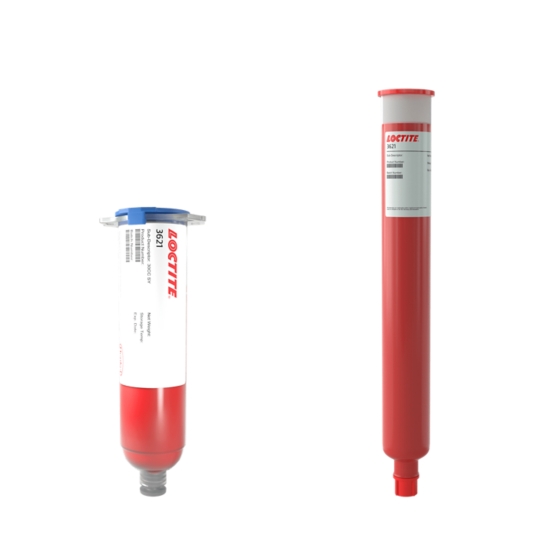LOCTITE 3621
- One component
- Chipbonder
- Very High dispense speed
Product Description
LOCTITE 3621 epoxy adhesive is a Chipbonder designed for the bonding of surface mounted devices to printed circuit boards prior to wave soldering. Particularly suited for applications where very high dispense speeds, high dot profile, high wet strength and good electrical characteristics are required. Particularly suited where dispense speeds greater than 35,000 dots/h are required. Dispense speed ranges from 25000 to 50000 dots per hour.
LOCTITE 3621 has been used successfully for small part bonding in lead free processes with water and alcohol based fluxes under conditions outlined in the Environmental Resistance section.
Cure schedule
- 30 minutes @ 150°C
Note: Sufficient time must be added to allow the bond location to reach the desired cure temperature. Curing profiles should be developed for each device. Bond strength achieved in practice will vary considerably depending on the SMD component type, adhesive dot size and the type, grade and degree of cure of the solder mask/resist.
Technical Specifications
| General Properties | |
| Specific Gravity Specific Gravity Specific gravity (SG) is the ratio of the density of a substance to the density of a reference substance; equivalently, it is the ratio of the mass of a substance to the mass of a reference substance for the same given volume. For liquids, the reference substance is almost always water (1), while for gases, it is air (1.18) at room temperature. Specific gravity is unitless. | 1.22 |
| Thermal Properties | |
| Glass Transition Temperature (Tg) Glass Transition Temperature (Tg) The glass transition temperature for organic adhesives is a temperature region where the polymers change from glassy and brittle to soft and rubbery. Increasing the temperature further continues the softening process as the viscosity drops too. Temperatures between the glass transition temperature and below the decomposition point of the adhesive are the best region for bonding. The glass-transition temperature Tg of a material characterizes the range of temperatures over which this glass transition occurs. | 110 °C |
| Thermal Conductivity Thermal Conductivity Thermal conductivity describes the ability of a material to conduct heat. It is required by power packages in order to dissipate heat and maintain stable electrical performance. Thermal conductivity units are [W/(m K)] in the SI system and [Btu/(hr ft °F)] in the Imperial system. | 0.3 W/m.K |
| Electrical Properties | |
| Volume Resistivity Volume Resistivity Volume resistivity, also called volume resistance, bulk resistance or bulk resistivity is a thickness dependent measurement of the resistivity of a material perpendicular to the plane of the surface. | 1.3x1015 Ohms⋅cm |
| Physical Properties | |
| Viscosity Viscosity Viscosity is a measurement of a fluid’s resistance to flow. Viscosity is commonly measured in centiPoise (cP). One cP is defined as the viscosity of water and all other viscosities are derived from this base. MPa is another common unit with a 1:1 conversion to cP. A product like honey would have a much higher viscosity -around 10,000 cPs- compared to water. As a result, honey would flow much slower out of a tipped glass than water would. The viscosity of a material can be decreased with an increase in temperature in order to better suit an application | 3,000 mPa.s |



